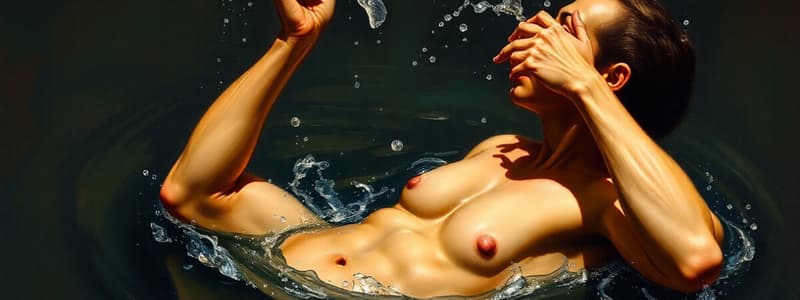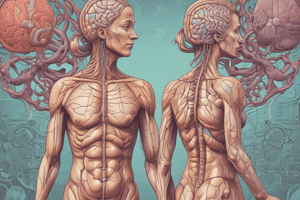Podcast
Questions and Answers
Which electrolyte plays a major role in muscle contraction and neurotransmitter release?
Which electrolyte plays a major role in muscle contraction and neurotransmitter release?
- Magnesium
- Calcium (correct)
- Phosphate
- Sodium
- Chloride
Which function of the urinary system is directly related to blood pressure regulation? (Select all that apply)
Which function of the urinary system is directly related to blood pressure regulation? (Select all that apply)
- Control of extracellular fluid volume (correct)
- Filtration of plasma proteins
- Regulation of blood calcium
- Excretion of urea
- Erythropoietin secretion
The urinary system helps maintain blood solute concentrations by regulating all of the following ions EXCEPT:
The urinary system helps maintain blood solute concentrations by regulating all of the following ions EXCEPT:
- Mn2+ (correct)
- Na+
- Cl-
- K+
- Ca2+
Which layer surrounds each kidney and consists of fibrous connective tissue?
Which layer surrounds each kidney and consists of fibrous connective tissue?
What is the primary purpose of the renal pelvis?
What is the primary purpose of the renal pelvis?
Which structure transports urine from the renal pelvis to the bladder?
Which structure transports urine from the renal pelvis to the bladder?
The functional units of the kidney, responsible for filtering blood and forming urine, are called:
The functional units of the kidney, responsible for filtering blood and forming urine, are called:
What role do podocytes play in the renal corpuscle?
What role do podocytes play in the renal corpuscle?
Which structure is the site where blood enters the kidney to begin filtration?
Which structure is the site where blood enters the kidney to begin filtration?
Glomerular filtration occurs as a result of pressure differences in which specific region?
Glomerular filtration occurs as a result of pressure differences in which specific region?
Which of the following pressures opposes filtration at the glomerulus?
Which of the following pressures opposes filtration at the glomerulus?
Blood flows into the glomerulus through which blood vessel?
Blood flows into the glomerulus through which blood vessel?
After filtrate passes through the loop of Henle, where does it travel next?
After filtrate passes through the loop of Henle, where does it travel next?
Which of these structures does blood enter immediately after leaving the glomerulus?
Which of these structures does blood enter immediately after leaving the glomerulus?
The peritubular capillaries primarily surround which part of the nephron?
The peritubular capillaries primarily surround which part of the nephron?
The vasa recta is essential in:
The vasa recta is essential in:
Which process is responsible for moving useful substances from the filtrate back into the blood?
Which process is responsible for moving useful substances from the filtrate back into the blood?
In the proximal convoluted tubule, which substance is actively reabsorbed alongside sodium?
In the proximal convoluted tubule, which substance is actively reabsorbed alongside sodium?
Which segment of the nephron loop is impermeable to water?
Which segment of the nephron loop is impermeable to water?
Tubular secretion is essential for:
Tubular secretion is essential for:
Which ions are secreted in the distal convoluted tubule to help regulate pH?
Which ions are secreted in the distal convoluted tubule to help regulate pH?
Which hormone increases the permeability of the collecting duct to water?
Which hormone increases the permeability of the collecting duct to water?
Aldosterone primarily regulates the balance of which ion in the body?
Aldosterone primarily regulates the balance of which ion in the body?
What effect does ADH have on urine concentration?
What effect does ADH have on urine concentration?
In response to low blood calcium, the parathyroid hormone acts on which segment of the nephron?
In response to low blood calcium, the parathyroid hormone acts on which segment of the nephron?
Which hormone is released in response to high blood volume and promotes sodium excretion?
Which hormone is released in response to high blood volume and promotes sodium excretion?
What is the primary role of chloride in the extracellular fluid?
What is the primary role of chloride in the extracellular fluid?
An increase in blood osmolality would likely trigger:
An increase in blood osmolality would likely trigger:
The main buffer system that regulates pH in the blood is:
The main buffer system that regulates pH in the blood is:
Respiratory acidosis is typically caused by:
Respiratory acidosis is typically caused by:
An increase in blood pH above the normal range is known as:
An increase in blood pH above the normal range is known as:
Which of the following compensates for metabolic acidosis?
Which of the following compensates for metabolic acidosis?
Hyperventilation is most likely to cause which acid-base imbalance?
Hyperventilation is most likely to cause which acid-base imbalance?
Which of the following hormones is released in response to low blood pressure and initiates the RAAS pathway?
Which of the following hormones is released in response to low blood pressure and initiates the RAAS pathway?
Angiotensin II acts directly to:
Angiotensin II acts directly to:
Aldosterone is secreted by the adrenal cortex in response to:
Aldosterone is secreted by the adrenal cortex in response to:
Which of the following is a primary effect of angiotensin II?
Which of the following is a primary effect of angiotensin II?
In the RAAS pathway, aldosterone promotes the reabsorption of which electrolyte?
In the RAAS pathway, aldosterone promotes the reabsorption of which electrolyte?
Which electrolyte is primarily responsible for establishing resting membrane potential in muscle cells?
Which electrolyte is primarily responsible for establishing resting membrane potential in muscle cells?
A deficiency of calcium in the blood is known as:
A deficiency of calcium in the blood is known as:
Which electrolyte is essential for blood clotting and bone health?
Which electrolyte is essential for blood clotting and bone health?
Hyperkalemia is characterized by elevated levels of which ion in the blood?
Hyperkalemia is characterized by elevated levels of which ion in the blood?
Which organ system is primarily responsible for detecting changes in blood osmolality?
Which organ system is primarily responsible for detecting changes in blood osmolality?
Thirst is generally triggered when blood osmolality:
Thirst is generally triggered when blood osmolality:
When dehydrated, ADH levels are expected to:
When dehydrated, ADH levels are expected to:
Which of the following increases water reabsorption without affecting electrolyte levels?
Which of the following increases water reabsorption without affecting electrolyte levels?
Severe dehydration could lead to an increase in which of the following conditions?
Severe dehydration could lead to an increase in which of the following conditions?
The countercurrent multiplier system is located primarily in the:
The countercurrent multiplier system is located primarily in the:
The descending limb of the loop of Henle is permeable to:
The descending limb of the loop of Henle is permeable to:
Which hormone plays a key role in regulating the medullary osmotic gradient?
Which hormone plays a key role in regulating the medullary osmotic gradient?
Urea recycling is important because it:
Urea recycling is important because it:
The ascending limb of the loop of Henle actively transports:
The ascending limb of the loop of Henle actively transports:
Which part of the nephron filters blood plasma?
Which part of the nephron filters blood plasma?
After filtrate passes through the renal corpuscle, it enters which structure?
After filtrate passes through the renal corpuscle, it enters which structure?
Which structure provides blood flow directly to the glomerulus?
Which structure provides blood flow directly to the glomerulus?
Glomerular capillaries are specialized to:
Glomerular capillaries are specialized to:
The role of the efferent arteriole in the nephron is to:
The role of the efferent arteriole in the nephron is to:
The micturition reflex is primarily controlled by:
The micturition reflex is primarily controlled by:
Which muscle in the bladder wall contracts to expel urine?
Which muscle in the bladder wall contracts to expel urine?
The internal urethral sphincter is controlled by:
The internal urethral sphincter is controlled by:
Voluntary control over micturition is managed by:
Voluntary control over micturition is managed by:
Which hormone decreases urine volume by increasing water reabsorption?
Which hormone decreases urine volume by increasing water reabsorption?
Aldosterone's effect on sodium reabsorption directly influences:
Aldosterone's effect on sodium reabsorption directly influences:
If blood pressure is too low, which hormone is released to constrict arterioles and raise blood pressure?
If blood pressure is too low, which hormone is released to constrict arterioles and raise blood pressure?
Excessive release of ADH would most likely cause:
Excessive release of ADH would most likely cause:
The kidney's ability to produce concentrated urine depends primarily on:
The kidney's ability to produce concentrated urine depends primarily on:
ANP is released by the:
ANP is released by the:
Flashcards
Blood pressure regulation (urinary system)
Blood pressure regulation (urinary system)
The urinary system controls extracellular fluid volume to regulate blood pressure.
Urinary system electrolyte regulation (EXCEPT)
Urinary system electrolyte regulation (EXCEPT)
The urinary system regulates sodium (Na+), calcium (Ca2+), and chloride (Cl−) ions but NOT manganese (Mn2+).
Renal capsule
Renal capsule
The fibrous connective tissue layer surrounding the kidney.
Renal pelvis function
Renal pelvis function
Signup and view all the flashcards
Ureter function
Ureter function
Signup and view all the flashcards
Nephron
Nephron
Signup and view all the flashcards
Podocytes
Podocytes
Signup and view all the flashcards
Renal artery/blood entry
Renal artery/blood entry
Signup and view all the flashcards
Filtration pressure (glomerular)
Filtration pressure (glomerular)
Signup and view all the flashcards
Blood colloid osmotic pressure (BCOP)
Blood colloid osmotic pressure (BCOP)
Signup and view all the flashcards
Afferent arteriole
Afferent arteriole
Signup and view all the flashcards
Efferent arteriole
Efferent arteriole
Signup and view all the flashcards
Reabsorption
Reabsorption
Signup and view all the flashcards
Proximal convoluted tubule (PCT) reabsorption
Proximal convoluted tubule (PCT) reabsorption
Signup and view all the flashcards
Loop of Henle - Descending limb
Loop of Henle - Descending limb
Signup and view all the flashcards
ADH (Antidiuretic Hormone)
ADH (Antidiuretic Hormone)
Signup and view all the flashcards
Hypokalemia
Hypokalemia
Signup and view all the flashcards
Effect of Hypokalemia
Effect of Hypokalemia
Signup and view all the flashcards
Role of Calcium in the body
Role of Calcium in the body
Signup and view all the flashcards
Hypercalcemia
Hypercalcemia
Signup and view all the flashcards
Phosphate buffer system
Phosphate buffer system
Signup and view all the flashcards




